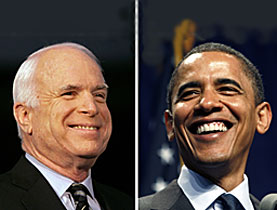The longest campaign

Personalities
Two years ago, no one could have predicted just how dramatic this year’s campaign for president of the United States would become.
The two last presidential elections have been very close, and this one will be too. Memories of 2000 and 2004 bring alive one fundamental peculiarity of the US voting system: citizens do not vote directly for their candidates but for “electors” in the respective states.
According to the principle of “winner take all” a majority of Democratic or Republican votes will translate into electors of one state all voting for the winning party. A candidate with more popular votes may still end up the loser in the electoral college, and thus not become president. Ask Al Gore about it!
Given this system, and with the major party strengths again being closely matched in some key states, the outcome of the election is bound to rest on the votes of this group of about 14 or 18 states. Those are the ones where for historical, economic, or social. reasons, the Republican-leaning population in one region is counter-weighed by Democratic-leaning people in another.
Another uncertainty is the role of a growing segment of non-party-affiliated, Independent, voters.
At the outset of the campaign, the Democrats sensed such widespread disenchantment with the Republicans that they devised an “all-states” strategy for winning, not just a narrow battle over the swing states. Such a truly nationwide effort also suited one of the candidates, Barack Obama, very well because he enjoyed early, enthusiastic, support among voters who were looking for a clear break with the old ways of politics.
The personal factor is always crucial in runs for the American Presidency. On the Republican side, there was little to make one candidate stand out clearly in the primary contests; Senator John McCain emerged as the candidate.
In contrast, the two Democratic candidates – both senators – that vied for the nomination were “firsts”: a woman, Hillary Clinton, and an African-American man with broad appeal, Barack Obama. Both were placed similarly on a progressive-conservative continuum, but found resonance in different sections of the population. It made the run difficult for each, but had the benefit of activating a much larger base of potential voters.
The Democratic campaign became an unprecedented nationwide sweep in which Obama gained through his charismatic appeal, especially to the young, and Clinton built on the memories of better economic times under her husband as well her loyal support by middle-aged and older women. The outcome of the nomination process was fairly close, but it was invigorating for the Democratic party and quite fair.
The next phase, between the primary results in the spring and the conventions in the summer, and the final phase, up to Election Day in November, would continue to be shaped by personality factors much more than by issues. So everyone thought.
Issues anyone?
In terms of substance, even a presidential election should be based on the issues, that is, bringing in a new administration in order to solve burning problems the country faces.
The campaign of 2008 has been curiously twisted in this regard, and that story alone is worth pondering. In the early outlooks, observers often noted that this election would be about the war in Iraq, the foreign policy and military adventure started by President Bush.
Even though the Democrats, once they gained a majority in Congress in 2006, were not able to stop the war, it was assumed that their anti-war presidential candidate would gain broadly-based support from most voters, especially as the Republican candidate, John McCain, supported a lasting military effort in Iraq. The election would be about war and peace, so to speak.
However, because the military surge of 2007/2008 was beginning to show a decline in casualties, and because of the long drawn-out primary battle between distinctly different personalities, the caliber of the protagonists again moved to the foreground. Who had more executive experience? Who would make a better commander in chief? Who had more personal appeal and was of the right age?
Just as some of the answers to these questions were getting sorted out, by convention time, Senator McCain landed a bombshell in the personalities arena by choosing as vice-presidential candidate Alaskan Governor Sarah Palin, who had very little to show in terms of fitness for office but a supercharge of personality and potential to emotionally attract the right-wing Republican base.
The head of the Republican campaign now ventured the opinion that “… this election is not about issues. It is about a composite view of what people take away from these candidates.”
Issues redux
But then came the next twist! In mid-September, the US financial market was rocked to its foundations.
The threat of a worldwide financial collapse stared everyone in the face. Not only did this require solid and measured reactions among the candidates, it threw the economy onto center stage of the election, where it may well stay until the day of the vote.
Within little more than a week, we were back to issues, indeed the bread and butter issue for virtually everyone; the vanishing of credit could throw the American economy into a new Great Depression.
Polls and the final spurt
Who will govern the United States? The best, most capable, of candidates, or someone “just like me”, “the guy next door” that I am comfortable with (Bush in 2000 and 2004)?
Says Newsweek, “…there is a mad love of mediocrity in this country. ‘They think they’re better than you!’ is the refrain that (highly competent and cynical) Republican strategists have set loose among the crowd, and the crowd has grown drunk on it once again. ‘Sarah Palin is an ordinary person!’ Yes, all too ordinary.”
Is that what the presidency is all about? If a majority of Americans thinks so, this country is in even more trouble than we thought.
Jurg Siegenthaler emigrated to the United States from Switzerland in 1967, and is now living near Washington, DC. He is a graduate of Bern University (Dr.rer.pol., 1966) and taught social policy analysis at American University.
His fields of teaching and research also encompassed economic history, social theory and research methods. Throughout his career, he has maintained close comparative interests in the US and Switzerland.
He is associated with the Institute for Socio-Financial Studies, a research non-profit that has done a lot of work improving financial literacy at the community level.
Since his retirement, Jurg Siegenthaler has broadened his involvement in community organizations and in the arts. He is married and lives with his wife Linda in Silver Spring, Maryland.

In compliance with the JTI standards
More: SWI swissinfo.ch certified by the Journalism Trust Initiative











You can find an overview of ongoing debates with our journalists here . Please join us!
If you want to start a conversation about a topic raised in this article or want to report factual errors, email us at english@swissinfo.ch.